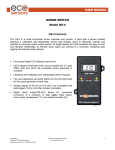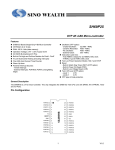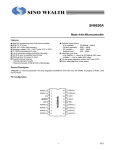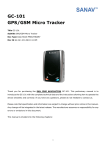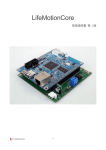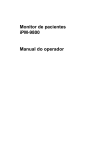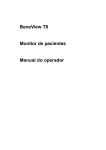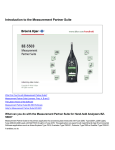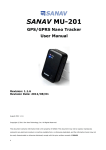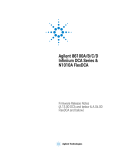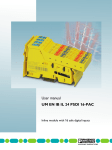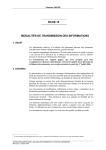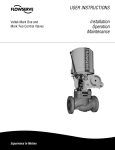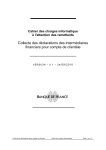Download VIEW PDF - Matrix Test Equipment
Transcript
ASX-16C/D
AFS-12WB
DTS
OPERATING MANUAL
ver.1.2
MODELS ASX-16C/D, AFS-12WB AND DTS OPERATING MANUAL
SECTION I - OPERATING INFORMATION ..................................................3
1-1 ..........................................................................................................INTRODUCTION........3
1-2 ..................................................................................FEATURES OF THE ASX-16C/D........3
1-3 ..............................................................SOFTWARE INTERFACE FOR THE ASX-16C/D........3
1-4 ........................................................................................ASX-16C/D COMMANDS
4
1-5 ...............................................................MANUAL OPERATION OF MODEL AFS-12WB
12
1-6 .................................................................REMOTE CONTROL OF MODEL AFS-12WB
12
1-7 ........................................................................................AFS-12WB COMMANDS
13
1-8 .......................................................TYPICAL SOFTWARE FOR THE MODEL AFS-12WB
13
1-9 .................................................ADJUSTING THE OUTPUT LEVELS OF THE ASX-16C/D........13
1-10 ................................................PERFORMING TESTS WITHOUT USING ALL CARRIERS........14
1-11 ............................................................CALIBRATING THE ASX-16C/D BASE LEVELS........15
1-12 .................................................ADJUSTING ASX-16C/D OSCILLATOR FREQUENCIES........17
1-13 ....................................................................FREQUENCY ADJUSTMENT PROCEDURE........18
SECTION II - THEORY OF OPERATION .....................................................20
2-1 ..........................................................................................................INTRODUCTION........20
2-2 ............................................................OPERATION OF THE GENERATOR CONTROLLER........20
2-3 .........................................................................................RF GENERATOR MODULES........20
2-4 ..........................................................................................MODULATION GENERATOR........21
2-5 ................................................................................AFS-12WB/ FILTER SELECTORS........21
2-6 .........................................................OPERATION OF AFS-12WB MICROCONTROLLER........21
SECTION III - REPAIRS TO THE EQUIPMENT ..........................................22
3-1 ..........................................................................................................INTRODUCTION........22
3-2 .....................................................................REPAIRS TO THE GENERATOR MODULES........22
3-3 ......................................................................................REPAIRS TO THE AFS-12WB
22
3-4 ..........................................................................................MISCELLANEOUS REPAIRS........23
SECTION IV - SPECIAL DTS DISTORTION MEASUREMENTS ................24
4-1 ..........................................................................................................INTRODUCTION........24
4-2 ...........................................................................................................FLOW CHARTS........24
SECTION V – DIAGRAMS ...........................................................................30
2
SECTION I - OPERATING INFORMATION
1-1 Introduction
The Model ASX-16C/D (or the ASX-16C/D portion of the DTS) typically contains: a bank of Generator
Modules (with attached filters), a Modulation Generator, one or more sets of programmable RF
attenuators (typically 0 dB to 81 dB), and a set of coaxial RF relays. The block diagram of Figure 1
illustrates the ASX-16C/D's major interconnections.
The Model AFS-12WB contains a bank of remotely-selectable RF filters, as detailed in Figure 5 and
Section 2-5.
For the Model DTS, information on controlling any additional equipment can be found in the manuals
provided by the additional equipment's manufacturers, and DTC-C/ATI-100 Software User Manual.
1-2 Features of the ASX-16C/D
The basic Model ASX-16C/D contains a bank of crystal-controlled modules which can be individually
turned on, turned off, 100 percent modulated with a 15.75 KHz (typical) square wave, set for CW (no
modulation), and output-level adjusted over approximately a 15 dB range. This 15 dB range allows the
outputs of individual carriers to be individually adjusted (tilted) to match specific application requirements.
The linearity of output level adjustment is approximately plus or minus 0.25 dB deviation over each 5 dB
of this 15 dB range. The output of this module bank is passed through an RF attenuator, which can be
varied over a typical range of 0 to 81 dB in 1 dB steps. An optional 0.5 dB step attenuator is also
available. In some units, the modulation frequency can be changed to 1 KHz, thereby allowing special
distortion measurements to made with an improved "noise floor."
If your DTS-C is equipped with a Frequency Synthesizer, special ASX-16C/D commands may allow its
signals to be used separately, or to be combined with the carrier signals from the ASX-16C/D. This
feature is used when making Composite Second Order Beat and Discrete Second and Third Order tests.
The DTS-C is typically equipped with a set of RF coaxial relays which are used to reconfigure the RF path
of the signals, allowing the routing to, or the bypassing of, most of the included equipment.
1-3 Software Interface for the ASX-16C/D
There are two types of commands which can be sent to the ASX-16C/D: SLAVE commands and
HANDSHAKE commands. All valid SLAVE commands are executed as soon as they are received. The
HANDSHAKE commands utilize and require two-way communications. In practice, the host computer
(IEEE-488 system controller) sends a HANDSHAKE command to the ASX-16C/D, then the host computer
reads the ASX-16C/D's response. This software "handshake" must be completed (by reading the
ASX-16C/D's response). If the ASX-16C/D's response is not read, the ASX-16C/D's interface to the
IEEE488 bus will be locked up until it is completed.
Any spaces in received commands are ignored. Commands to the ASX-16C/D/AFS-12WB can contain
either UPPER CASE or lower case letters. Commands to the ASX-16C/D/AFS-12WB can be terminated
with either a "carriagereturn/line-feed" (ASCII code 13 followed by ASCII code 10), or with just a "linefeed" character. Responses from the ASX-16C/D will be terminated with a "carriage-return" (only) on
power-up (or after a reset). If the host computer (customer's equipment) requires a "carriagereturn/
linefeed" termination, the output character sequence from the ASX-16C/D can be changed by using the
OUTCRLF command. The OUTCRLF and OUTCR commands are described in this Section for the
ASX-16C/D.
3
Whenever "+/-" appears in the chart below, it indicates that an unsigned number will be assumed to be
positive, and a number preceded by a "-" sign will be taken as negative. Do not include a "+" in front of
numerical data which is supposed to be positive. For example, negative 12 is sent as "-12"; positive 12 is
sent as "12".
When a module number is indicated in the following command chart, the module number should be an
integer from 1 to N (where N is the highest module number in your system--N has a maximum value of
255). If a module number of 0 (zero) is used (on commands where such a value is permitted), the
command is applied simultaneously to all modules in the ASX-16C/D. The Channel Designation Sheet
provided with the unit indicates the relationship between module number and the generated/received
frequency of the module.
The chart starting on the next page lists the commands available in the ASX-16C/D portion of the DTS-C.
Some commands may be unavailable in your equipment. Commands which are optional or which require
additional equipment are marked "(optional)". Command literals are indicated in UPPER CASE; variables
are indicated in lower case.
1-4 ASX-16C/D COMMANDS
SIGNAL MEANING
TYPE EX.
Adata: Sets the ASX-16C/D's RF Attenuator to the value of the "data" (in dB) in 1 dB steps
over a range of 0 to 81 dB. In units with the 0.5 dB option, the "data" can have a value
of 0 to 82.5 in 0.5 dB steps. In units with more than one bank of RF Attenuators, this
command sets all available banks to the "data" value. When the unit is reset, all RF
attenuators are set to the maximum value.
SLAVE A20
A11
AAdata: Sets only the ASX-16's "A" RF Attenuator to the value of the "data" specified in the
(optional) command (see"Adata" command for details). The other RF attenuators are not
changed by this command. This command is only used in units with more than one
bank of RF attenuators.
SLAVE AA20
AA11
ABdata: Sets only the ASX-16's "B" RF Attenuator to the value of the "data" specified in the
(optional) command (see "Adata" command for details). The other RF attenuators are not
changed by this command. This command is only used in units with more than one
bank of RF attenuators.
SLAVE AB20
AB11
ACdata: Sets only the ASX-16's "C" RF Attenuator to the value of the "data" specified in the
(optional) command (see "Adata" command for details. The other RF attenuators are not
changed by this command. This command is only used in units with more than one
bank of RF attenuators.
SLAVE AC20
AC11
AV: In units with one bank of RF attenuators, requests the Value of the ASX-16's RF
Attenuator setting. For standard units, the response from the ASX-16 is a three-digit
number (with leading zeros, as necessary) from 000 to 081. For units with the 0.5 dB
option, the response from the ASX-16 is a three-digit number, followed by either ".0" or
".5" (with leading zeros, as necessary) from 000.0 to 082.5 (the extra digit allows for
future use of attenuators whose maximum value may exceed 99 dB. In units with
multiple attenuator banks, use the "AVA", "AVB", or "AVC" commands instead of the
"AV" command.
4
HANDSHAKE AV
SIGNAL MEANING
TYPE EX.
AVa: In units with more than one RF Attenuator bank, requests the Value of the ASX-16's RF
(optional) Attenuator specified by "a." For standard units, the response from the ASX-16 is a
three-digit number (with leading zeros, as necessary) from 000 to 081. For units with
the 0.5 dB option, the response from the the ASX-16 is a three-digit number, followed
by either ".0" or ".5" (with leading zeros, as necessary) from 000.0 to 082.5 (the extra
digit allows for future use of attenuators those maximum value may exceed 99 dB. This
command is only used in units with more than one bank of RF attenuators.
BHmodule, Sets the specified module's Base Level using the high resolution mode, whose range is
level: 0 to 300. Do not use this command until you have received proper training from
Matrix Test Equipment. This command replaces offers the older "Bmodule,level"
command. It offers four times the resolution of the "Bmodule, level." See the Lmodule
commands, below, for information on adjusting the level of a module. When a module's
Base Level is set, its carrier is automatically turned on CW. A module value of 0 (zero)
will cause the command to be carried out on all the modules. The "Bmodule,level"
command is ignored if the Base Level flag is set. Resets of the ASX-16C/D will not
affect the Base Levels if the BD command has been used to set the Base Level flag.
Note that the comma (,) must be sent.
HANDSHAKE AVA
AVB
AVC
SLAVE BH1,212
BH0,300
Note: Base Level commands are normally for factory use only (used when the Base
Levels are first set). Periodic adjustments to the Base Level are usually not necessary,
except when the ASX-16C/D battery-backed-up memory has become corrupted or has
been replaced.
BC: Clears the Base Level flag in the ASX-16C/D's battery-backed-up RAM.Only when this
flag is cleared can the Base Levels be adjusted, using the Bmodule,level command.
Do not use this command until you have received proper training from Matrix
Test Equipment. If this flag is not set before the unit is reset or the power is turned off,
the Base Levels of all channels will be automatically set to 75 on the next reset or
power-up.
SLAVE BC
BD: Sets the Base Level flag in the ASX-16C/D's battery-backed-up RAM.When this flag is
set, commands to adjust the Base Levels (Bmodule,level) are ignored. When this flag
is set, the Base Levels are unaffected by resets and power-up.
SLAVE BD
BF: Requests the status of the Base Level Done flag. If the flag has been set (using the
"BD" command), the response from the ASX-16C/D is "S". If the flag is not cleared, the
response is "C".
HANDSHAKE BF
BS: Sets the Base Level flag in the ASX-16C/D's battery-(optional)backed-up RAM. When
this flag is set, commands to adjust the Base Levels (Bmodule,level) are ignored.
When this flag is set, the Base Levels are unaffected by resets and power-up.
SLAVE BS
BVmodule: Requests the low resolution Value of the specified module's Base Level. The response
from the ASX-16C/D is a 3-digit number (with leading zeros, if necessary) from 000 to
075. This command has been replaced by the "BVHmodule" command, but the older
command has been retained for compatibility with user-written software.
NOTE: See Section 1-9 for information about customer calibration of the ASX-16C/D
module Base Levels.
5
HANDSHAKE BV1
BV122
SIGNAL MEANING
TYPE EX.
BVHmodule: Requests the high resolution Value of the specified module's Base Level. The
response from the ASX-16C/D is a 4-digit number (always with a leading zero), from
0000 to 0300. BYPASS causes the RF filter bank to be SLAVE BYPASS bypassed by a
set of RF relays.
HANDSHAKE BVH1
BVH122
Cmodule: Applies power to the specified module and sets the module for CW (unmodulated)
operation. If the module number is 0 (zero), all modules are set for CW operation (the
normal arrangement of carriers for a Composite Triple Beat Test).
SLAVE C1
C100
C0
Fmodule, Sets specified module(s) to the specified level using the low resolution mode. The
level: "level" can be any integer value from 0 to 180. If a module of "0" (zero) is specified, all
modules are set to the specified level. Although this command alters the module's level
stored in RAM, it does not affect the output carrier amplitudes until the module is
next leveled. The "Fmodule,level" command has been replaced by the
"FHmodule,level" command, but the older command is retained for compatibility with
older, user-written software. See the "L" commands, below, for more information on
adjusting the level of a module. Note that the comma (,) must be sent.
SLAVE F1,63
F67,70
F0,75
F0,180
FHmodule, Sets specified module(s) to the specified level using the high resolution mode. The
level: "level" can be any value from 0 to 720. If a module of "0" (zero) is specified, all
modules are set to the specified level. This command provide four times the resolution
of the older "Fmodule, level" command. Although this command alters the module's
level stored in RAM, it does not affect the output carrier amplitudes until the module
is next leveled. See the "L" commands, below, for more information on adjusting the
level of a module. Note that the comma (,) must be sent.
SLAVE FH1,252
FH67,280
FH0,300
FH0,720
FC: Clears the FREQUENCY ADJUST flag in the ASX-16C/D's battery-backed-up RAM.
Only when this flag is cleared can the carrier frequencies be adjusted. If this flag is still
cleared when the unit is reset or the power is turned off, the Frequency adjustments of
all channels will be automatically set to their middle settings on reset or power-up.
SLAVE FC
FD: Sets the FREQUENCY ADJUST flag in the ASX-16C/D's battery-backed-up RAM.
When this flag is set, commands to adjust the module’s frequencies are ignored. If this
flag is set, the module’s frequency settings are unaffected by resets.
SLAVE FD
FF: Requests the status of the Frequencies Done flag. If the flag has been set (using the
"FD" command), the response from the ASX-16C/D is "S". If the flag is cleared, the
response is "C".
HANDSHAKE FF
FRmodule, Adjusts the specified module's carrier frequency. The maximum change for each
change: "FRmodule" command is limited to a range of + or - 255 steps; however, the FRmodule
command can be sent several times to the ASX-16C/D if it is desired to move in steps
greater than 255. The total range of adjustment covers 4096 steps. To return a carrier
to its "center" frequency, send a change value of 0 (zero). To set all carrier to their
"center" frequencies, use the command "FR0,0." Negative values move the carrier
down in frequency; unsigned values move the carrier up in frequency. See Section 1-3
for details. Resets do not affect the frequency settings. This command will be ignored
if the FREQUENCY ADJUST flag is set (see above). Note that the comma (,) must be
sent.
NOTE: The FRmodule command is a SLAVE command. No checking is performed to
see if the FRmodule command will cause the ASX-16C/D to exceed the maximum or
minimum steps. Use the FRVA command (below) before changing the frequency of a
module.
6
SLAVE FR2,250
FR4,-12
FR45,0
FR0,0
SIGNAL MEANING
TYPE EX.
FRVAmodule: Requests the current Value of the specified module's frequency adjustment setting.
The value sent by the ASX-16C/D is a four-digit number (with leading zeros, if
necessary), from 0 to 4095. This command replaces the older "FRV" command (see
below).
HANDSHAKE FRVA1
FRVA122
NOTE: To determine if there is adjustment room left in a given module, use the FRVA
command to obtain its step value. To avoid frequency-setting errors, make sure the
commands sent to the ASX-16C/D never cause a frequency adjustment to move above
4095 or to drop below 0.
FRVmodule: Requests the current Value of the specified module's frequency adjustment setting.
This command has been replaced by the "FRVA" command, but has been retained to
insure compatibility with previously-written software. The step value sent by the
ASX-16C/D is the actual step, from 0 to 4095, divided By 16. This reduces the data to
a number between 0 and 255. The response from the ASX-16C/D is a 3-digit number
(with leading zeros, if necessary), from 000 to 255.
HANDSHAKE FRV1
FRV122
NOTE: To use the FRV command to determine if there is sufficient adjustment room
left in a given module, multiply the step value obtained by 16. This gives the
approximate step setting, which is a number in the range of 0 to 4095. Note that a
range of 16 steps will return the same response. For example, steps 1600 through
1615 will return a value of "100." For this reason, using the new, "FRVA" command is
preferred.
FS: Sets the FREQUENCY ADJUST flag in the ASX-16C/D's (optional) battery-backed-up
RAM. When this flag is set, commands to adjust the modules' frequencies are ignored.
If this flag is set, the module’s frequency settings are unaffected by resets.
SLAVE FS
GEN: Sets the optional SOURCE/GENERATOR coaxial relays to the GENERATOR (ASX-16)
(optional) position. The SYSTEM output will contain only the ASX-16 signals.
SLAVE GEN
GFIN: Switches frequency counter into RF path.
(optional)
NOTE: Due to strong signals generated by the frequency counter which can interfere
with other equipment, the frequency counter must be switched OUT, except when
frequency measurements are made.
SLAVE GFIN
GFOUT: Switches the frequency counter out of the RF path.
(optional)
SLAVE GFOUT
HH: Halts the Modulation Generator in its High state. This causes all modules which are set
for 100% modulation to drop their carrier levels by a minimum of 35 dB and to enter a
CW (unmodulated) mode. All modules which are set for CW operation will function
normally. Under certain circumstances, this feature can save programming steps when
it is necessary to frequently switch the modules' operating modes.
SLAVE HH
HL: Halts the Modulation Generator in its Low state. This causes all modules which are set
for 100% modulation to operate as if they were set for CW operation. All modules
which are set for CW operation will function normally. Under certain circumstances, this
feature can save programming steps or time, such as when switching from an X-mod
test to a CTB test.
SLAVE HL
7
SIGNAL MEANING
TYPE EX.
HU: Restores the Modulation Generator's normal operation.
I: Requests the ASX-16C/D's customer- programmed identification number. This ID
number is programmed by setting the "CUSTOMER DEVICE IDENTIFIER" switches
on the ASX-16C/D's Microcontroller board. The response from the ASX-16C/D is a
three-digit number from 000 to 099.
SLAVE HU
SLAVE I
K: Requests the status of the test module switch (located on the test/switch fixture).
(optional) Response from the ASX-16C/D is either N (switch is open), or G (switch is closed).
HANDSHAKE K
Lmodule, Sets the indicated module=s carrier Level up (unsigned) bor down (minus sign) by the
+/-steps: requested number of steps in the low resolution mode. There are 181 steps, from 0 to
180. Each step is approximately 0.1 dB. This command has been replaced by the
"LHmodule,+/-steps" command, which has four times the resolution (approximately
0.025 dB per step). The "Lmodule,+/-steps" command has been retained to maintain
compatibility with older, user-written programs. Note that the comma (,) must be sent.
HANDSHAKE L12,15
L12,-15
L0,75
L0,-75
The response from the ASX-16C/D is either an "N" for "no-go" (cannot move by that
number of steps) or a "G" for "go" (can move by that number of steps). When a
module's level is changed, its carrier is automatically turned on CW.
When the specified module number is 0 (zero), indicating all modules, if any module
cannot be stepped by the requested amount, an N response is generated, and no
levels are changed.
NOTE: In the low resolution mode, each module has a range of approximately 15 dB,
which is covered by a 150-steps range of adjustment (from 0 to 150). In the high
resolution mode, each module has a range of approximately 15 dB,which is covered by
a 600-steps range of adjustment (from 0 to 600). The change in dB per step has a
linearity error of approximately 0.25 dB over each 5 dB portion of the15 dB adjustment
range.
LHmodule, Sets the indicated module's carrier level up (unsigned) or down (minus sign) by the
+/-steps: requested number of steps in the high resolution mode. There are 721 steps, from 0 to
720. Each step is approximately 0.025 dB. This command has four times the resolution
of the older "Lmodule,+/-steps" command, which has been retained to maintain
compatibility with older, user-written programs. Note that the comma (,) must be sent.
The response from the ASX-16C/D is either an "N" for "no-go" (cannot move by that
number of steps) or a "G" for "go" (can move by that number of steps). When a
module's level is changed, its carrier is automatically turned on CW. When the
specified module number is 0 (zero), indicating all modules, if any module cannot be
stepped by the requested amount, an N response is generated, and no levels are
changed.
HANDSHAKE LH12,60
LH12,-60
LH0,300
LH0,-300
LMmodule: Requests the step Level of the specified Module in the low resolution mode. Response
from the ASX-16C/D is a 3-digit number (with leading zeros, as necessary) from 000 to
180. This command has been replaced by the "LMHmodule" command, but has been
retained to maintain compatibility with older, user-written software.
HANDSHAKE LM1
LM100
LMHmodule: Requests the step Level of the specified Module in the high resolution mode.
Response from the ASX-16C/D is a 4-digit number (always with a leading zero), from
0000 to 0720.
8
HANDSHAKE LMH1
LMH100
SIGNAL MEANING
TYPE EX.
Mmodule: Applies power to the specified module and sets the module for 100% Modulated
operation. If the module number is 0(zero), all modules are set for 100% Modulated
operation.
SLAVE M1
M100
M0
NON: In a Model DTS, applies power to the Noise Source.
(optional)
NOTE: The NON and NOFF commands affect only the power to the Noise Source.
The R command (see below) must be used to switch the Noise Source into and out of
the RF circuit.
SLAVE NON
NOFF: In a Model DTS, removes power from the Noise Source.
(optional)
SLAVE NOFF
NORMAL: Removes the RF bypass which is caused by the BYPASS command.
OUTCRLF: Changes the output termination characters for data transmitted from the ASX-16C/D
to be "carriage-return/line-feed."
SLAVE NORMAL
SLAVE OUTCRL
F
NOTE: The OUT commands do not affect the requirements for data to the ASX-16C/D.
Commands to the ASX-16C/D can be terminated with either a "carriage-return"
followed by a "line-feed," or with just a "line-feed.”
OUTCR: Changes the output termination character for data transmitted from the ASX-16C/D to
"carriage-return"(only). See the NOTE, above. This is the reset/power-up default mode.
Pmodule: Shuts "off" the carrier of the specified module in accordance with the mode set by the
Q command (see below). If the module number is 0 (zero), the carriers of all modules
are shut "off."
SLAVE OUTCR
SLAVE P1
P121
P0
QLOW: Sets the Quality factor of the"off" discussed in the P, S, and T commands. In the QLOW
mode, all "off" carriers are unmodulated, with their amplitudes at least 35 dB lower than
normal. Activating the QLOW mode does not affect the pre-existing conditions of the
modules. The QLOW command affects only those modules which are subsequently
turned "off" using the P, S, or T command. The ASX-16C/D powers-up in the QLOW
mode.
SLAVE QLOW
QOFF: Sets the Quality factor of the "off" discussed in the P, S, and T commands. In the QOFF
mode, all "off" modules have their power removed. In this mode, the oscillators will
"cool off" (that is, if a module is left "off" while the QOFF mode is active, It will not be at
its "warmed-up" frequency when power is reapplied). Activating the QOFF mode does
not affect the pre-existing condition of the modules. The QOFF command affects only
those modules which are subsequently turned "off" using the P, S, or T command.
SLAVE QOFF
9
SIGNAL MEANING
TYPE EX.
Rdata: In a Model DTS, configures the "R" internal relays and/or (optional) the relays located
in the "white box" (the test/switch fixture). The "data" portion of the command specifies
the new positions for all these. In the standard Model DTS, There are eight(8) "R"
relays (or sets of relays). Additional relays can be added.
SLAVE see below
In the "data" portion of the command, positions are specified, in order, relay 1 first,
relay 8 last. All eight of the relays must be specified, even if their switching
positions do not matter in that particular test configuration – and even if your
configuration does not contain the full set of eight relays. "U" puts a relay in its Up
position. "D" puts a relay in its Down position. "X" indicates that the relay's position is
unimportant (WARNING: the "X" does not mean that the former relay position will
be retained. You should only use "X" if you really don't care which position that
relay is in).
If you ordered the multiple relay-bank option for your unit, you can address up to four
banks of eight relays (a total of 32 relays). To address a bank (1 through 4) place that
bank's number immediately after the "R" in the command. For example, to control Bank
2, use a command similar to "R2UUUUDDDD". If you leave out the Bank number, the
command will be applied to Bank 1. Example shown uses eight relays. If your unit has
more than eight relays ion one bank, the additional data should be placed after the
eight character of the “data”. (Example for ten relays: RUDDUXDDUUU).
The following example probably does not agree with the equipment in your unit, but
demonstrates the kind of cautions to look into to avoid equipment damage.
Example: RDUXDUUDU connects the combined ASX-16 and/or Frequency
Synthesizer outputs, to the input of the device under test. The output of the device
under test is connected to the input of the AFS-12WB filter bank. The output of the filter
bank is routed to the input of the Network Analyzer. To protect the RF Power Meter
from accidental overload or static electricity, one of the relays is used to connect its RF
input to its own Reference Output connector.
RESET: Sets the ASX-16C/D to the same power-on state created by pressing the Front Panel
RESET button (see Section 1-2.2). This feature is only available on Model ASX-16C/D,
Serial Number 14 and later.
SLAVE RESET
Smodule, Turns "off" all modules except the two specified in the command. These two are set to
module: CW (unmodulated) operation. The S command is used for setting up the ASX-16C/D
for a Second Order distortion test. The Frequency Synthesizer (used to generate the
frequency-offset carrier) is set up separately. Note that the comma (,) must be sent.
SLAVE S28,37
S2,112
SMmodule: Requests the operating mode of the specified Module. Response from the ASX-16C/D
(optional) is always a three-character string. For CW (unmodulated) operation, the response is
"CW " (including one blank space). For modulated operation, the response is "MOD".
For power off (non-operation), the response is "OFF". For power low(-35 dB down, or
more), the response is "LOW".
HANDSHAKE SM1
SM100
SRC: Sets the optional SOURCE/GENERATOR coaxial relays to the SOURCE (Head-end)
(optional) position. The SYSTEM output will contain only the Head-end signals.
SLAVE SRC
Tmodule, Turns "off" all modules except the three modules specified in the command. These
module, three are set to CW (unmodulated) operation. The T command is used for setting up
module: the ASX-16C/D for a discrete Third Order distortion test. The Frequency Synthesizer
(used to generate the frequency-offset carrier) is set up separately. Note that the
comma (,) must be sent.
SLAVE S6,8,9
S2,41,42
10
SIGNAL MEANING
TYPE EX.
V+/-data: In units with one RF attenuator bank, Varies the RF Attenuator by the amount (in dB)
specified by the data. The ASX-16 responds with an N if the attenuator cannot
bevaried by the requested amount, or with a G if the attenuator can be varied by the
requested amount. In units with multiple RF attenuator banks, use the "VA+/-data", "VB
+/-data" or "VC+/-data" command.
Va+/-data: In units with more than one RF Attenuator bank, Varies (optional) the RF Attenuator
specified by "a" by the amount (in dB) specified by the data. The ASX-16C/D responds
with an N if the "A" attenuator cannot be varied by the requested amount, or with a G if
the attenuator can be varied by the requested amount. The "B" and "C" Attenuators are
unaffected by this command. This command is only used in units with more than one
bank of RF attenuators.
Xmodule: Turns on all modules in the 100% modulated mode, except for the specified module,
which is instead set for CW(unmodulated) operation. The X command is used for
making X-mod(Cross-modulation) tests.
11
HANDSHAKE V12
V-12
HANDSHAKE VA12
VA-12
VB12
VB-12
VC12
VC-12
SLAVE X1
X13
X101
1-5 Manual Operation of Model AFS-12WB
Manual operation of the AFS-12WB is quite simple. The narrow-band and wide-band models function
identically. Each filter can be selected by entering its three-digit identification number on the front panel
keyboard. The three-digit display will indicate the entry as each key is pressed. Even if your unit has
fewer than one-hundred filters, a three-digit entry must still be used. For example, to select filter number
1, press "001" on the keypad.
The keyboard can also be used to scan to the next or previous filter by using the Scan Up ("#") or Scan
Down ("✽") key, respectively. Note that scanning may extend beyond the actual number of filters in your
unit. This feature allows additional filters to be added by you at a later time.
If you need to RESET the AFS-12WB (due to a malfunction), manual reset can be accomplished by
simultaneously pressing the Scan Up and Scan Down keys.
The Model AFS-12WB can be in either the Local or Remote mode. In the Model AFS-12WB, the front
panel's LOCAL and REMOTE lights will indicate that the most recent filter selection was received from
either the keypad or from the IEEE488 bus, respectively.
Configuration Mode:3-3
For models with Attenuators and/or the PA-2020 Pre/Post Amplifier installed, a special Configuration
Mode can be activated to manually control these options. Entering “000” on the keypad will activate the
configuration mode. Once in this mode, you can Scan Up (“#”) or Scan Down (“✽”) to cycle through the
Attenuator settings in 5dB increments (0~80dB). The list below shows the commands for the PA-2020:
200 Sets PA-2020 to PA1IN (Preamp 1 Only)
300 Sets PA-2020 to PA1OUT (Preamp 1 Only)
400 Sets PA-2020 to PA2IN (Preamp 2 Only)
500 Sets PA-2020 to PA2OUT (Preamp 2 Only)
600 Sets PA-2020 to PAIN (Preamps 1 & 2 Only)
700 Sets PA-2020 to PAOUT (Preamps 1 & 2)
If you enter configuration mode by mistake, simply enter “000” again to exit.
1-6 Remote Control of Model AFS-12WB
The Model AFS-12WB can be controlled, remotely, through the IEEE488 bus. Most remotely-controlled
equipment made by Matrix Test Equipment uses two types of IEEE-488 commands: SLAVE commands
and HANDSHAKE commands. SLAVE commands are one-way commands, which are executed (if
possible) as soon as they are received. HANDSHAKE commands utilize two-way communications, and
are more complicated in their operation. The Model AFS-12WB uses both kinds of commands.
Any space-characters embedded in commands received through the IEEE488 bus are ignored by the
Model AFS-12WB. Commands can contain either UPPER CASE or lower case letters. Commands sent to
the Model AFS-12WB can be terminated with either a "carriagereturn/line-feed" (ASCII code 13 followed
by ASCII code 10), or with just a "line-feed" character.
When a "filter" number is specified in the following chart, the filter number should be an integer from 1 to
N (where N is the highest filter number in your system). The Filter Designation Sheet included with your
unit indicates the relationship between the filter number and its frequency.
The following commands are available on the Model AFS-12WB.
Command literals are indicated in UPPER CASE; variables are indicated in lower case.
12
1-7 AFS-12WB COMMANDS
SIGNAL MEANING
TYPE EX.
Ffilter: Causes the specified filter to be selected.
SLAVE F1
F16
FAmaxpos: Causes the Model AFS-12WB to begin an automatic scanning of its filters, from the
first position to the maximum position number which was specified by the data
"maxpos". Note that this is the position number and not the usual filter designation.
SLAVE FA7
FA12
Example: Assume your Model AFS-12WB has twelve (12) filters with designations:
2,4,5,6,8,9,10,12,14,15,17, and 20. If you want a rapid scan of filter 2 (in the first
position) through filter 20 (in the twelfth position), use the command "FA12.”
Scanning will continue endlessly until either the AFS-12WB is turned off, or until the
AFS-12WB is reset by simultaneously pressing the "#" and "✽" keys.
This command is primarily intended for factory testing purposes.
FV: Requests the current filter number Response from the AFSW is a three-digit number
(with leading zeros, as necessary), indicating the 3-digit identification of theFilter
currently selected.
HANDSHAKE FV
1-8 Typical Software for the Model AFS-12WB
The examples in this section are written in Hewlett-Packard Basic, compatible with many HP computers.
Some modifications may be necessary to adapt these examples for use with other computers.
As shipped from the factory, the Model AFS-12WB is set for IEEE-488 bus address 23.
To select filter number 5, use either of the following commands:
OUTPUT 723; "F5"
or
OUTPUT 723; "f5"
To enable automatic filter scanning from filter position 1 through filter position 8, use either of the following
commands:
OUTPUT 723; "FA8"
or
OUTPUT 723; "fa8"
1-9 Adjusting the Output Levels of the ASX-16C/D
The first step in leveling the ASX-16C/D's output is to measure the amplitude of a "typical" carrier, usually
one near the middle of the ASX-16C/D's frequency spectrum. The RF attenuators are then adjusted
(using the ASX-16C/D's A or V commands) to bring the carrier level of this "typical" carrier to within one
dB of the desired level. The final "fine-tuning" of carrier amplitudes is performed using the ASX-16C/D's L
command. This allows the individual modules to be leveled or sloped exactly as required by a particular
application.
13
To perform the leveling, an external power meter, or spectrum analyzer, or similar device, must be used.
In order to cover all possible power-measuring devices, a procedure, rather than a complete program, is
provided:
1. Set up the ASX-16C/D's RF attenuators as described in the first paragraph of Section 2-5.7.
2.
Turn off all ASX-16C/D carriers using the command:
400 OUTPUT 724; "P0"
3. Set the variable M to the module number of the module
turn on this module, using the command:
500 OUTPUT 724; "C"; M
which is to be turned on, then
4. Measure the output level of the module to see if it is close enough. If the Level is acceptable,
skip to Step 6). If the level is not acceptable, generate an "error" value E by using the following
formula (E is the error; R is the power meter reading; D is the desired power meter reading):
510 E = R – D
Convert E to steps (.025 dB per step) by multiplying the error by 40:
520 E = 40 ✽ E
Note: due to errors in linearity, some modules may produce steps greater than .025 dB. If you
run into this problem, multiply by 20, instead of 40, in line 520.
5. Correct the level of module #M (and read the ASX-16C/D's response) by using the following
commands:
600 OUTPUT 724; "LH"; M; ","; E
610 ENTER 724 USING "#,A"; R$
620 IF R$="N" THEN GOTO 2000
Lines 2000 through 2020 handle modules which have run out of adjustment range:
2000 PRINT "ERROR"
2010 PRINT "MODULE NUMBER "; M; " IS AT ITS LIMIT"
2020 STOP
6. When the amplitude of this module is correct, repeat Steps 2 through 5 for each of the
remaining modules. If the carrier levels are to be sloped, the value of D, in Step 4 will change
for each module. If the desired level cannot be obtained because the measured level
alternated between being too great or too small, as the level is moved up or down by a single
step, follow the directions in the Note in Step 4.
1-10 Performing Tests Without Using All Carriers
It is often desirable to make distortion measurements using a limited number of carriers. For example, the
ASX-16C/D might be outfitted with seventy-six channels, but the desired X-mod test is to be performed
using only channels 2 through W. The carriers below channel 2 (module number 8, in this example) and
those above W (module 42) must be turned off. In this example, the undesired carriers are generated by
modules 1 through 7 and modules 43 through 76.
160
170
171
172
173
174
176
180
190
OUTPUT 724; "A35"
OUTPUT 724; "X8"
FOR I=1 TO 7
OUTPUT 724; "P"; I
NEXT I
FOR I=43 TO 76
175 OUTPUT 724; "P"; I
NEXT I
OUTPUT 723; "X8"
ENTER 723 USING "#,A,6✽"; R$,D
(ETC.)
14
Line 170 turns on all modules 100% modulated, except for module #8,
which is turned on CW.
Lines 171 through 173 and lines 174 through 176 turn off the two groups
of undesired carriers.
1-11 Calibrating the ASX-16C/D Base Levels
Each ASX-16C/D generator module is individually adjustable over an approximately 25.5 dB range. This
25.5 dB range is associated with 255 Step Levels of about 1/10 dB for each Step Level in the lowresolution mode, and 1020 steps of .025 dB in the high-resolution mode. The linearity error over any 5 dB
range of adjustment is approximately plus or minus 0.24 dB. Due to differences in operating frequencies
(and therefore in output stages and output filters), the modules= maximum output levels vary over a wide
range. As explained below, and in Figure 2, the "Base Level" setting is used to compensate for these
differences, allowing all modules to have nearly identical output levels and ranges of adjustment..
To insure that all modules can be set to the same output power levels, the maximum output power is
lowered for the strongest (highest output power) modules. This is accomplished by reducing the
maximum 25.5 dB range of adjustability for all modules to approximately 15 dB (+ 6dB, -9dB). This 15 dB
range is associated with 600 Step Levels in high-resolution (instead of the maximum of 1020). The most
recent Step Level data for each module is stored in the ASX-16C/D's battery backed-up RAM, retaining
the information even when the ASX-16C/D is reset or turned off.
In addition to the Step Level, each generator module has its own "Base Level" (stored in the same
protected RAM). This Base Level establishes the "base" (lowest level) of a module's 15 dB range of
adjustability. This relationship is illustrated in Figure 2. By raising or lowering the Base Level setting, a
module's maximum output power can be raised or lowered, respectively. Because the maximum Step
Level for a module is 720 (maximum Base Level is step 300.
Figure 3 illustrates the outputs of three modules, before Base Level calibration. Even though all modules
are set for their "default" level of Step 480, and are set to their maximum Base Level of 300, their output
levels vary over a 4 dB range, due to the difference in their output stages and output filters. For the sake
of this discussion, let us assume that the weakest module in the ASX-16C/D is the one with an output of
-9 dBm (the module on the left).
Figure 4 illustrates the outputs of the same modules, after Base Level calibration. Note that when
properly calibrated, all modules produce a "flat" output level when all are set to Step Level 480. The Base
Level of the middle module has been reduced by 80 steps, reducing its output power by 2 dB; the righthand module's Base Level has been reduced by 160 steps, reducing its output power by 4 dB.
Because the modules vary somewhat in their linearity (dB per Step), there will be some variation in the
amount of level change obtained from the "L" command (see Section 1-4).
Below, is a procedure for updating the ASX16C/D's Base Level calibration. Normally, Base Level
calibration is performed only at the Matrix Test Equipment factory (prior to shipping). If periodic
readjustment of the Base Levels is desired, or if additional modules are added to the ASX16C by the
customer, or if the Base Level information is lost to due equipment failure, the provided procedure will
allow you to re-establish proper Base Levels. Certain equipment is required to perform this calibration:
Model ASX-16C/D (or Model DTS), power meter with a minimum of 0.1 dB resolution, host computer with
IEEE-488 bus interface and software. Note that Step 2) calls for a setting of 10 dB of RF attenuation. This
is to protect the power meter from possible overloading. If your power meter does not need this
protection, delete this step.
Consult Section 1-3 for information on using the ASX-16C/D remote control commands.
15
1.
Reset the ASX-16C/D by using the front panel RESET button. Allow the ASX-16C/D to warm
up for at least fifteen minutes.
2.
Set the ASX-16C/D's RF attenuator to 10 dB, using the command: A10
3.
Put all modules on level step 480, using the command: F0,480
4.
Set the Base Level of all modules to step 300, using: B0,300
5.
Turn off the carriers of all modules, using the command: P0
6.
Turn on a single module (in this example, assume module 1): C1
7.
Use the power meter to read and record the module's output power.
8.
Repeat Steps 5 through 7, recording each module's output power level.
9.
Using the output power data, locate the module whose output was lowest (weakest). The
power output of the weakest module is called the "Reference Level."10)
Turn off the carriers of all modules, using the command: P0
11. Turn on a single module (in this example, assume module 1): C1
12. Use the power meter to read the module's output power. If the power level is within
0.25 dB of the "Reference Level," skip to Step 17.
13. If the power level is more than 0.25 dB higher than the "Reference Level," the module's
Base Level is set too high.
14. Read the module's Base Level setting, using the following HANDSHAKE command (again,
we will assume module 1): BVH1(Don't forget to complete the HANDSHAKE!)
15. Each high-resolution Base Level step changes the output power by approximately
0.025 dB. Increase or decrease the Base Level value, as appropriate, then send the new
(calculated) Base Level to the ASX-16C/D, using the following command(assume the new
Base Level should be 264, and assume we are still using module 1): B1,264
16. Go back to Step 14. If the reading is still not correct, continue to adjust the Base Level. If
the Base Level value goes below 0 or above 300, something is wrong with either the
module, power meter, or with the RF connections.
17. When the module's power output is correct, repeat Steps 10 through 16 for the next module.
When all modules have been completed, use the BD command to set the Base Level Done
flag in the ASX-16C/D, by sending to the ASX-16C/D the command: BD
16
1-12 Adjusting ASX-16C/D Oscillator Frequencies
The operating frequency of each ASX-16C/D generator module can be adjusted over a 4096-step range,
to compensate for age-related frequency drift in the oscillator crystals.
The "FR" and "FRVA" commands are used to make the adjustments.
The "FR" command is used to adjust the frequency of each module.
The general form of this command is: FRmodule,change
(where "module" specifies the module whose level is to be adjusted, and "change" specifies the amount
of adjustment to be made).
Examples:
FR2,250
FR4,-12
FR45,0
FR0,0
The "FR" command is a "slave" command (no error checking is performed); therefore it is important that
you read this section completely before attempting any frequency adjustments.
The "change" vaue is limited to a range of + or - 255 steps; however, the "FR" command can be sent
several times to the ASX-16C/D if you need to move the adjustment by more than 255 steps. If the
"change" value is set to 0 (zero) the frequency adjustment is returned to its middle step (step 2048).
Negative "change" values move the carrier lower in frequency; unsigned "change" values move the
carrier higher in frequency. See Section 1-4 for details.
If the "module" value is set to 0 (zero), the requested change is performed on all available modules.
Normally, such a command would make no sense, however a special case exists when the "change"
value is 0. When both "module" and "change" are zero, the adjustments of all carrier frequencies are
returned to their middle steps (step 2048); this is the proper starting point if the frequency adjustments
ever become "scrambled."
Because the "FRmodule,change" command performs no error checking, it is possible for you to create a
"wrap-around" situation. This occurs when you move an adjustment above step 4095 or below step zero.
In "wrap-around," the next step above 4095 is step 0, and the next step below step 0 is 4095. To avoid
this problem, use the "FRVA" command before attempting to adjust the frequency of any module. The
general form of the "FRVA" command is:
FRVAmodule
(where "module" specifies the module whose step level value is to be read).
Examples:
FRVA1
FRVA122
The "FRVA" command is a "handshake" command which requests the current setting of the specified
module's frequency adjustment. The response from the ASX-16C/D is the current step, from 0 to 4095.
The ASX16C always returns a four-digit number, inserting leading zeros, if necessary.
17
1-13 Frequency Adjustment Procedure
Certain equipment is required to perform this adjustment: Model ASX-16C/D (or Model DTS), frequency
counter with a resolution and stability appropriate for your adjustments, host computer with IEEE-488 bus
interface and software.
Consult Section 1-3 for information on using the ASX-16C/D remote control commands.
1.
Reset the ASX-16C/D by using the front panel RESET button. Allow the ASX-16C/D to warm
up for at least thirty minutes.
2.
Set the ASX-16C/D's RF attenuator to 0 dB, using the command: A0
3.
For Model DTS only, make sure the frequency synthesizer is off, then switch the GF relay to
its IN position, using the command: GFIN
Also, make sure the Model DTS's GA/GB relay is in its GB position using the command: GB
4.
Turn off the carriers of all modules, using the command: P0
5.
Turn on a single module (in this example, assume module 1): C1
6.
Use the frequency counter to read and record the module's frequency (F1). If frequency
counter is controllable through the IEEE-488 bus, this entire procedure can be automated,
otherwise, it will be necessary to have the measured frequency entered through the
computer's keyboard.
7.
Compute the frequency error. If the frequency is within acceptable limits, move on to the
next module, starting with step 4 (above).
8.
Read the current frequency adjustment step for this channel using the "FRVA" command.
For example, for module 1, use: FRVA1
This is a handshake command. Make sure you read the response. If you need to move up in
value, but the response was "4095", or if you need to move down in value, but the response
was "0000" you have reached the adjustment limit. In this case, either the module needs a
new crystal or something is wrong with your measuring procedure or with your frequency
counter.
9.
Assuming there is adequate adjustment range remaining, move the frequency up or down
100 steps using the "FR" command. Move the step level up to increase the frequency;
move the step level down to decrease the frequency. For example, to move module 1 up
100 steps, use the command: FR1,100
Use the frequency counter to read and record the module's new frequency (F2). If it is now
within acceptable limits, move on to the next module, starting with step 4 (above).
If additional adjustment is needed, calculate the steps/Hertz ratio for this module, using the
following formula: steps/Hertz = 100 / | F1-F2 |
10. Now multiply the remaining frequency error by the steps/Hertz ratio to determine
approximately how many additional steps of adjustment are required. For example, if F0 is
the desired frequency, the approximate amount of change required is: change = | F0 - F2 |
X steps/Hertz
11. If the previous value returned by the "FRVA" command indicated the module was close to
the end of its adjustment, use the "FRVA" command again to make sure there is still
sufficient room for the required adjustment.
12. Assuming there is adequate adjustment range remaining, move the frequency up or down by
the number of steps calculated in step 10 (above) using the "FR" command. Use an
unsigned value to increase the frequency, or a negative value to decrease the frequency.
For example, if we wish to move module 1 down in frequency by 254 steps, use: FR1,-254
18
If you need to move in steps greater than 255, use multiple instructions. For example to
move module 1 down by 310 steps, send the following two commands (each command must
be sent separately): FR1,-255 & FR1,-55
13. Re-check the frequency. If additional adjustment is necessary, go back to step 10.
14. Repeat Steps 4 through 13 for each module.
15. After all channels have been adjusted, turn off the carriers of all modules, using the
command: P0
16. For Model DTS only, return the GF relay to its OUT position, using the command: GFOUT
19
SECTION II - Theory of Operation
2-1 Introduction
The theory of operation of the Model ASX-16C/D and Model AFS-12WB are covered separately. The
DTS-C includes both of these devices. In the DTS-C, the ASX-16C/D portion controls the following
(some of these features may be omitted from your DTS-C):
Generator Modules
All 1 dB and 10 dB RF Step Attenuators
All RF amplifiers and Coaxial Relays
GA/GB Coaxial Relay
GFIN/GFOUT Coaxial Relay
DC Power to an optional Noise Source
Polarity Reversing Relay for Unit Under Test's DC Power
The AFS-12WB portion of the DTS-C handles the AReceiver@ Filter Selection.
2-2 Operation of the Generator Controller
On power-up (or reset), the Generator Controller sets parts of the ASX-16C/D to known, protected states.
When the unit is first turned on, the DC power supply to the Generator modules is turned off. This is to
protect any external equipment (such as a power meter sensor) from a sudden surge of RF power which
might otherwise occur on power-up. After the Generator Controller has gone through its start-up
procedure, leaving its peripherals in a "safe" condition, the Generator Controller turns on the DC supply to
the modules. If the Generator Controller is reset manually (without turning its power off), the DC power
supply is unaffected (and remains on).
On reset, the ASX-16C/D's RF attenuators are automatically set to their highest level of attenuation. If the
ASX-16C/D is part of a Model DTS, the Generator Controller briefly "exercises" the RF coaxial relays in
the switch/test fixture (resulting in a dstiinctive series of audible "clunks" from the switch/test fixture). This
can reduce contamination problems caused by relay contacts which never change position.
Unless a new, unprogrammed RAM has just been installed in the Generator Controller, neither the Base
Levels nor module levels are affected by a reset or power-up. The ASX-16C/D is equipped with a batterybacked-up RAM, allowing all "module level" data to be retained. This eliminates the need to re-level the
ASX-16C/D carriers each time the unit is reset.
The Generator Controller receives its commands through the IEEE488 bus. If a command is received
which requires a response from the ASX-16C/D, the Generator Controller responds through the IEEE-488
bus. Section II of this manual covers the IEEE488 operations of the ASX-16C/D.
2-3 RF Generator Modules
Each module can be independently turned on and off, modulated or operated in a CW (unmodulated)
mode. When a carrier is modulated, the modulating signal is provided by the ASX-16C/D's Modulation
Generator. A Mode control line, which runs from the Modulation Generator to all the Generator modules
(in a daisy-chain fashion), determines how the Modulation Generator's output should be used. When the
Mode line is at a low logic level, the normal 15.75 Kilohertz square wave is output by the Modulation
Generator. When the Mode line is at a high level, the Modulation Generator reproduces a data stream
which contains the control information for one or more of the ASX-16C/D's Generator modules. This data
stream has a serial format, consisting of bursts of twenty-four pulses, and is sent at a bit rate of
approximately 15750 bits per second. No data clock is required by this data, because the bits are selfclocking, with narrow pulses representing a logic 0, and wide pulses representing a logic 1.
20
2-4 Modulation Generator
The Modulation Generator's circuit is a crystal oscillator, followed by a frequency divider. In most units,
the oscillator operates at 15.75 Megahertz; its output frequency is divided by one-thousand, to 15.75
Kilohertz (KHz). In some units, an alternate modulation frequency, of 1 KHz, is also included. This
optional feature can be used to improve the "noise floor" for some distortion tests.
The modulations generator's signal is passed through a series of gates (selectors), which allow the
Modulation Generator's output to be set to any one the following four conditions:
1. Normal Modulation (continuous square wave)
2. High Level DC (modulation disabled high)
3. Low Level DC (modulation disabled low)
4. Data From Generator Controller (serial data for modules).
The selected output signal (one of the above four) is passed to a buffer circuit, whose output is capable of
driving the inputs of all the ASX-16C/D modules. On units equipped with the 1 KHz option, one of the
"disabled" states is replaced by the 1 KHz output state.
The Modulation Generator also produces a buffered copy of the Generator Controller's Modulation/Data
Mode signal. This Mode signal is passed to all the ASX-16C/D modules.
2-5 AFS-12WB/ Filter Selectors
The Model AFS-12WB is a remotely-controllable unit, which is also available with optional manual
controls. Both units contain a bank of filters which can (typically) be selected one-at-a-time. Remotecontrol operations are performed through the IEEE-488 interface bus. Both models are available with
either "narrow-band" or "wide-band" filters (the designation "WB" in AAFS-12WB@ indicates the normal
wide-band feature). The wide-band filters are capable of passing a much wider bandwidth than the
optional narrow-band filters, and are used in instances where you need to make multiple distortion
measurements using the same filter. For example, you may need to measure CTB (Composite Triple
Beat), CSO (Composite Second Order), Carrier-to-noise), and X-Mod (Cross-Modulation) distortions, all
on the same filter.
Except for the filter bandwidths and the hardware which performs the actual filter selection, the narrowband and wide-band models function identically.
2-6 Operation of AFS-12WB Microcontroller
Depending on the configuration of your AFS-12WB, on power-up (or reset), the Microcontroller either
disables all filters or selects the first filter in the filter bank. The normal default, especially on units with a
Channel display, is to select the first filter.
Depending on the actual configuration, the Microcontroller Board receives its commands through the
keyboard and/or through the IEEE488 bus.
The keyboard permits selection of a filter using a two-button sequence (or a three-button sequence, on
units with a 3-digit Channel). The previous or next filter can be selected by using the keyboard's Scan
Down ("✽") and Scan Up ("#") keys, respectively.
21
SECTION III - Repairs to the Equipment
3-1 Introduction
Repairs to the Model ASX-16C/D and AFS-12WB are discussed in the next two sections. Because the
Model DTS typically contains both an ASX-16C/D and an AFS-12WB, these sections also apply to the
DTS. Repairs to a DTS system fall into five general categories:
1. Generator Modules
2.AFS-12WB filter selection
3. Main Frame Harnessing
4. Support Equipment (Controllers, driver boards, et cetera)
5. Equipment Not Manufactured By Matrix Test Equipment.
The first four groups are covered in the chapters, below. For repairs to equipment not manufactured by
Matrix, consult the manuals supplied by the equipment's manufacturer.
3-2 Repairs to the Generator Modules
There are four ways in which a Generator module can fail:
1. Unstable, Intermittent Operation or No Output Power
2.Always CW (no modulation)
3.Always Modulated
4. Improper Response to L (Leveling) commands.
Any of these problems can be caused by bad continuity between the module and the control wiring,
power wiring, or coaxial cables. First check all coaxial connectors and wiring connections. All modules
receive their control signals from the Modulation Generator. If only one module is malfunctioning, the
problem is in that module. If the problem affects an entire section of modules, the problem is most likely in
the cabling. If all modules are affected, the problem may be in the modulation generator, or in the cables
leading to or from the Modulation Generator.
If there is a break in any of the coaxial cabling (which is daisy-chained from module to module), all
modules following the break will exhibit the same bad characteristics.
Another cause of no output (or intermittent output) is a stalled (or intermittently-stalling) oscillator.
If the malfunction still exists after checking for bad connections and for a stalled oscillator, the module will
have to be removed from the ASX-16C/D. After opening the module's case, look for any obvious signs of
damage, such as a charred component, or a broken connection. Although repairs can sometimes be
made by the customer, it is advised that any malfunctioning modules be returned to Matrix Test
Equipment for repairs. You can usually rearrange the cabling to "jump over" the defective module, thus
keeping the rest of the system operating until the defective module can be repaired.
3-3 Repairs to the AFS-12WB
Before assuming that there is a problem with the AFS-12WB, first use a spectrum analyzer to be sure that
there is a strong carrier present at the suspected filter's frequency. A failure in the AFS-12WB could be
caused by a bad filter or by a failure in the filter selection circuitry. To establish where the problem is
located, temporarily swap the coaxial connections of the suspected filter with one of the working filters.
The suspected filter will now be accessed using the working filter's access address, and the working filter
will be accessed using the suspected filter's access address. If the problem stays with the access
address, the problem is in the filter selection circuitry. If the problem stays with the filter, the filter has
failed or has become mis-tuned.
22
On the wide-band AFS-12WB units, an array of light emitting diodes (LEDs) on the boards indicate which
relays have been selected. This may aid you in hunting down a bad coaxial connection or a bad relay.
3-4 Miscellaneous Repairs
The only ICs which cannot be substituted for, using commercially-available components, are the PROMs
on the ASX-16C/D and AFS-12WB Controller boards. Replacement PROMs for your equipment are
available from Matrix Test Equipment.
23
SECTION IV - SPECIAL DTS DISTORTION MEASUREMENTS
4-1 Introduction
The Model DTS can be outfitted with equipment which allows distortion measurements to be made with a
much better "noise floor" than a conventional spectrum analyzer, a Model AR-12, a Model R-12, a Model
R-75 or a Model R-76.
Typical equipment needed to use these special measurement techniques are (one from each category is
required):
Matrix Test Equipment ASX-16C/D or DTSB (Signal Generator)
Matrix Test Equipment AFS-12WB or DTS (Filter Bank)
Agilent (HP) 8591E (RF Spectrum Analyzer)
Agilent (HP) 8657A (Frequency Synthesizer)
Standard Research Systems (Audio Spectrum Analyzer)
The examples given in Section 4-2 are based on this list of equipment. The Generator (ASX-16C/D) and
Filter Bank (AFS-12WB) are assumed to be part of a Model DTS.
4-2 Flow Charts
The following flow charts provided are based on the configuration outlined in Section 3-1. The same
processes can be used with other equipment, providing they perform the same function.
The flow charts show how to perform Composite Triple Beat (CTB), Composite Second Order Beat (CSB)
and Cross-modulation (X-mod) measurements.
Certain conventions are used in the flow charts. A plain-language description is listed first. This may be
followed by a comment enclosed in square brackets "[ ]". Brackets will contain subsidiary information and
assumptions used in example instructions. Below these lines is a line enclosed in parentheses "( )". The
parentheses provide a sample instruction line for the specified device. This is supplied as a guide for
anyone writing a program to control all the equipment. These commands are provided only as a guide.
Additional commands may be required. If the phrase "[ USE A SUBROUTINE ]" appears in a step, it
indicates that a multi-line subroutine will be required to perform the step.
Some steps may be common to the three types of distortion measurements. "DUT" is the abbreviation for
Device Under Test. S.A. is the abbreviation for Spectrum Analyzer. When making measurement on HP
S.A., allow at least one-half second for settling. When making measurements on S.R.S. S.A., allow at
least one second for settling.
24
CTB/CSB
|
SETUP
|
SET ASX-16C/D TO OBTAIN THE DESIRED OUTPUT LEVEL FROM DUT
[ USE A LEVELLING SUBROUTINE ]
SET ASX-16C/D TO "QOFF" MODE
( QOFF )
SET UP ASX-16C/D/DTS RELAYS TO ROUTE SIGNAL AS FOLLOWS:
FROM OUTPUT OF DUT TO AFS-12WB TO HP S.A.
( RUDDUUDDUUX )
|
SET UP HP S.A.
REF ATTENUATOR: MANUAL @ 10 dB
( AT MAN )
( AT 10 DB )
AMPLITUDE REFERENCE @ -10 dBm
( RL -10 DM )
SET CENTER FREQUENCY TO MEASUREMENT FREQUENCY
[ EXAMPLE: 499.25 MHZ ]
( CF 499.25 MHZ )
SET SPAN @ 0 Hz
( SP 0 HZ )
RESOLUTION BANDWIDTH: MANUAL @ 30 KHz
( RB MAN )
(RB 30 KHZ )
VIDEO BANDWIDTH: MANUAL @ 30 KHz
( VB MAN )
(VB 30 KHZ )
|
SET ASX-16C/D TO 1.12 KHz MODULATION MODE
( MOD1KHZ )
MODULATE ALL ASX-16C/D CARRIERS
( M0 )
TURN OFF ANY UNUSED ASX-16C/D CARRIERS
[ USE A SUBROUTINE ]
|
SET UP S.R.S. S.A.
TURN OFF AUTOMATIC LIMIT TESTING
( TSTS 0 )
SELECT INPUT SOURCE A
( ISRC 0 )
SET GROUND: FLOAT, COUPLING: AC
( IGND 0 )
( ICPL 0 )
SET INPUT RANGE AT 0 dBV
( IRNG 0 )
[ IF THIS CREATES AN OVERLOAD, ADJUST INPUT RANGE ]
SET TOP REFERENCE @ -10 dBV
( TREF 0,-10 )
SET SPAN @ 390 Hz
( SPAN 11 )
25
TURN MARKER ON, CENTERED
( MRKR 0,1 )
( MRCN )
SET CENTER FREQUENCY TO 1.12 KHz
( CTRF 1120 )
|
BEGIN DISTORTION MEASUREMENT
|
WAIT 1 SECOND FOR SETTLING
[ USE A SUBROUTINE ]
READ Y VALUE OF S.R.S. S.A. MARKER
( MRKY? )
[ SAVE THE dBV VALUE AS "Y1" ]
|
GO TO CTB CONTINUED C OR GO TO CSB CONTINUED
CTB
CONTINUED
|
TURN OFF ASX-16C/D CARRIER WHOSE CHANNEL IS USED FOR CTB MEASUREMENT
[ EXAMPLE: CHANNEL 76 ]
( P76 )
|
SET HP S.A. ATTENUATOR TO 0 dB
( AT 0 DB )
SET AMPLITUDE REFERENCE TO -60 dBm
[ THIS IS A CHANGE IN LEVEL OF 50 dB ]
( RL -60 DBM )
|
SET S.R.S. S.A. INPUT RANGE @ -20 dBV
( IRNG -20 )
[ IF THIS CREATES AN OVERLOAD, ADJUST INPUT RANGE ]
WAIT 1 SECOND FOR SETTLING
[ USE A SUBROUTINE ]
READ Y VALUE OF S.R.S. S.A. MARKER
( MRKY? )
[ SAVE THE dBV VALUE AS "Y2" ]
|
CALCULATE THE DISTORTION
|
CTB (IN dB) = 50 + (Y2-Y1)/2
CSB
CONTINUED
|
RE-TUNE S.R.S. S.A. TO 1 KHz
( CTRF 1000 )
|
TURN OFF ASX-16C/D CARRIER WHOSE CHANNEL IS USED FOR CSB MEASUREMENT
[ EXAMPLE: CHANNEL 76 = 499.25 MHZ ]
( P76 )
|
SET SYNTHESIZER TO CARRIER FREQUENCY JUST TURNED OFF
[ EXAMPLE: 499.25 MHZ ]
( FR 499.25 MZ )
SELECT INTERNAL AM MODULATION @ 1 KHz AND 99%
26
( AM S3 )
( AM 99 PC )
ADJUST SYNTHESIZER AMPLITUDE UNTIL READING ON S.R.S. S.A. IS WITHIN .5 db OF Y1
[ USE A SUBROUTINE. ALLOW 1 SECOND BEFORE EACH READING ]
|
RECORD THE DIFFERENCE BETWEEN Y1 AND THE CURRENT Y VALUE AS "DY1"
|
SET SYNTHESIZER TO CSB MEASUREMENT FREQUENCY
[ EXAMPLE: 500.50 MHZ ]
( FR 500.50 MZ )
SET HP S.A. CENTER FREQUENCY TO CSB MEASUREMENT FREQUENCY
( CF 500.50 MHZ )
|
RE-TUNE S.R.S. S.A. TO 1.12 KHz
( CTRF 1120 )
READ Y VALUE OF S.R.S. S.A. MARKER
( MRKY? )
[ SAVE dBV READING AS "Y2" ]
|
TURN OFF SYNTHESIZER OUTPUT
( AP -127 DB )
|
(CSB CONCLUDED)
|
SET HP S.A. ATTENUATOR TO 0 dB
( AT 0 DB )
SET AMPLITUDE REFERENCE TO -60 dBm
[ THIS IS A CHANGE IN LEVEL OF 50 dB ]
( RL -60 DBM )
|
SET S.R.S. S.A. INPUT RANGE @ -20 dBV
( IRNG -20 )
[ IF THIS CREATES AN OVERLOAD, ADJUST INPUT RANGE ]
WAIT 1 SECOND FOR SETTLING
[ USE A SUBROUTINE ]
READ Y VALUE OF S.R.S. S.A. MARKER
( MRKY? )
[ SAVE THE dBV VALUE AS "Y3" ]
|
CALCULATE THE DISTORTION
|
CSB (IN dB) = 50 + (Y3-Y2-DY1)/2
X-MOD
|
SETUP
|
SET ASX-16C/D TO OBTAIN THE DESIRED OUTPUT LEVEL FROM DUT
[ USE A LEVELLING SUBROUTINE ]
SET ASX-16C/D TO "QOFF" MODE
( QOFF )
SET UP ASX-16C/D/DTS RELAYS TO ROUTE SIGNAL AS FOLLOWS:
FROM OUTPUT OF DUT TO AFS-12WB TO HP S.A.
( RUDDUUDDUUX )
27
|
SET UP HP S.A.
REF ATTENUATOR: MANUAL @ 0 dB
( AT MAN )
( AT 0 DB )
AMPLITUDE REFERENCE @ -10 dBm
( RL -10 DM )
SET CENTER FREQUENCY TO MEASUREMENT FREQUENCY
[ EXAMPLE: 499.25 MHZ ]
( CF 499.25 MHZ )
SET SPAN @ 0 Hz
( SP 0 HZ )
RESOLUTION BANDWIDTH: MANUAL @ 30 KHz
( RB MAN )
(RB 30 KHZ )
VIDEO BANDWIDTH: MANUAL @ 30 KHz
( VB MAN )
(VB 30 KHZ )
|
SET ASX-16C/D FOR 15.75 KHz MODULATION
( MODNORM )
MODULATE ALL ASX-16C/D CARRIERS
( M0 )
TURN OFF ANY UNUSED ASX-16C/D CARRIERS
[ USE A SUBROUTINE ]
|
SET UP S.R.S. S.A.
TURN OFF AUTOMATIC LIMIT TESTING
( TSTS 0 )
SELECT INPUT SOURCE A
( ISRC 0 )
SET GROUND: FLOAT, COUPLING: AC
( IGND 0 )
( ICPL 0 )
SET INPUT RANGE AT 0 dBV
( IRNG 0 )
[ IF THIS CREATES AN OVERLOAD, ADJUST INPUT RANGE ]
SET TOP REFERENCE @ -10 dBV
( TREF 0,-10 )
SET SPAN @ 390 Hz
( SPAN 11 )
TURN MARKER ON, CENTERED
( MRKR 0,1 )
( MRCN )
SET CENTER FREQUENCY TO 15.75 KHz
( CTRF 15750 )
|
BEGIN DISTORTION MEASUREMENT
|
WAIT 1 SECOND FOR SETTLING
[ USE A SUBROUTINE ]
READ Y VALUE OF S.R.S. S.A. MARKER
28
( MRKY? )
[ SAVE THE dBV VALUE AS "Y1" ]
|
TURN OFF ASX-16C/D CARRIER WHOSE CHANNEL IS USED FOR CTB MEASUREMENT
[ EXAMPLE: CHANNEL 76 ]
( P76 )
|
WAIT 1 SECOND FOR SETTLING
[ USE A SUBROUTINE ]
READ Y VALUE OF S.R.S. S.A. MARKER
( MRKY? )
[ SAVE THE dBV VALUE AS "Y2" ]
|
X-MOD (IN dB) = Y2-Y1
29
SECTION V – DIAGRAMS
30
31
100 Ohm
Modulation
Termination
Filter
Filter
(ASX-16X Module)
Oscillator
and
RF Amplifier
(ASX-16X Module)
Oscillator
and
RF Amplifier
Filter
Filter
Filter
(ASX-16X Module)
Oscillator
and
RF Amplifier
(ASX-16X Module)
Oscillator
and
RF Amplifier
(ASX-16X Module)
Oscillator
and
RF Amplifier
There are 16 modules per rack.
Lowest frequency starts from the top left to
the highest frequency ends at the bottom right.
Module location information:
Filter
(ASX-16X Module)
Oscillator
and
RF Amplifier
50 Ohm RF
Termination
0 to 11 dB
1dB Steps
LO Bank
HI Bank
Modulator
15.75 Khz & 1 KHz
(Opt. 15.625 KHz)
CATV Microcontroller Board
Attenuator Relay Driver Board
0 to 70 dB
10dB Steps
Electronic Programmable Step Attenuators
(75 Ohm Optional)
Type "N"
Type "BNC"
Type "F"
DWN. BY:
INSPECTED BY:
SHEET NO.:
1
CK
01-03-12 JM
DATE:
DWG. NO.:
SCALE:
1.0
REV.:
Figure 1
1.000:1.000
ASX-16B/C/D/P/E Block Diagram
200 WOOD AVE. MIDDLESEX, NJ 08846
GPIB-488 BUS
RF
OUTPUT
(50 Ohm Standard)
Type "N"
Type "BNC"
Type "SMA"
32
DWN. BY:
INSPECTED BY:
DATE:
1
CK
01-03-12 JM
SHEET NO.:
DWG. NO.:
SCALE:
1.0
REV.:
Figure 2
1.000:1.000
ASX-16B/C/D/P/E
Base and Step Levels
200 WOOD AVE. MIDDLESEX, NJ 08846
Base Level moves this
15dB "WINDOW" UP
or DOWN within the
limits of ABSOLUTE
Step 0 and ABSOLUTE
Step 1020.
ABSOLUTE step 1020. They output thier minimum power at
ABSOLUTE step 0. To insure that ALL MODULES can be adjustable
over the same range, some of the range of adjustability is sacrificed.
To prevent the strongest modules from producing too much power, their base levels
are lowered so that the strongest modules output the same range of output levels
as the weakest modules. (See Figures 3 and 4)
Level Step 0 (Lower Limit of Adjustement)
Level Step 480 (Level for FLAT output)
Level Step 720 (Upper Limit of Adjustment)
NOTE: Generator modules output their maximum available power at
Absolute Step 0 (Minimum Power Out)
Base Level
Absolute Step 1020 (Maximum Power Out)
33
Absolute Step 0
Absolute Step 1020
Absolute Step 0
Absolute Step 1020
Base Level
(Set to 300)
Base Level
(Set to 300)
POWER OUTPUT
-7 dBm @ Step 480
Level Step 0
Base Level
(Set to 300)
Base Level
(Set to 220)
POWER OUTPUT
-9 dBm @ Step 480
Level Step 0
Level Step 480
Level Step 720
Base Level
(Set to 140)
Example
(Base Level moved down by 80 steps = - 2 dB)
Figure 4. Equal output levels after Base Level calibration.
POWER OUTPUT
-9 dBm @ Step 480
Level Step 0
Level Step 480
Level Step 720
Example
(Base Level unchanged)
Figure 3. Output level variations with equal Base Levels.
POWER OUTPUT
-9 dBm @ Step 480
Base Level
(Set to 300)
POWER OUTPUT
-5 dBm @ Step 480
DWN. BY:
INSPECTED BY:
DATE:
1
CK
01-03-12 JM
SHEET NO.:
DWG. NO.:
SCALE:
1.0
REV.:
Figure 3 & 4
1.000:1.000
ASX-16B/C/D/P/E
Base and Step Levels
200 WOOD AVE. MIDDLESEX, NJ 08846
POWER OUTPUT
-9 dBm @ Step 480
Level Step 0
Level Step 480
Level Step 720
Example
(Base Level moved down by 160 steps = - 4 dB)
Level Step 0
Level Step 480
Level Step 480
Level Step 480
Level Step 0
Level Step 720
Level Step 720
Level Step 720
34
*RY1
CRS-4
INPUT
GPIB-488
Relay Driver
CATV Microcontroller
Keypad and Display
INPUT
(25 - 32)
(17 - 24)
(9 - 16)
(1 - 8)
CRS-8 I/O
CRS-4 I/O
(9 - 16)
O
P
T
I
O
N
A
L
*RY3
CRS-8
INPUT
(1 - 8)
*RY2
CRS-8
INPUT
Position #16
(BYPASS)
Position #15
(Terminated)
Filter #14
Filter #13
Filter #12
Filter #11
Filter #10
Filter #9
Filter #8
Filter #7
Filter #6
Filter #5
Filter #4
Filter #3
Filter #2
Filter #1
O
P
T
I
O
N
A
L
(9 - 16)
*RY5
CRS-8
OUTPUT
(1 - 8)
*RY4
CRS-8
OUTPUT
*RY6
CRS-4
OUTPUT
* = RF Coaxial Relay
(25 - 32)
(17 - 24)
(9 - 16)
(1 - 8)
DWN. BY:
1
SHEET NO.:
CK
INSPECTED BY:
DWG. NO.:
SCALE:
1.0
REV.:
Figure 5
1.000:1.000
AFS-12WB Block Diagram
(Typical 16CH Main Frame)
01-03-12 JM
DATE:
OUTPUT
200 WOOD AVE. MIDDLESEX, NJ 08846
PA-20-20A
Post Amplifier
1st amp 20dB
2nd amp 37dB


































